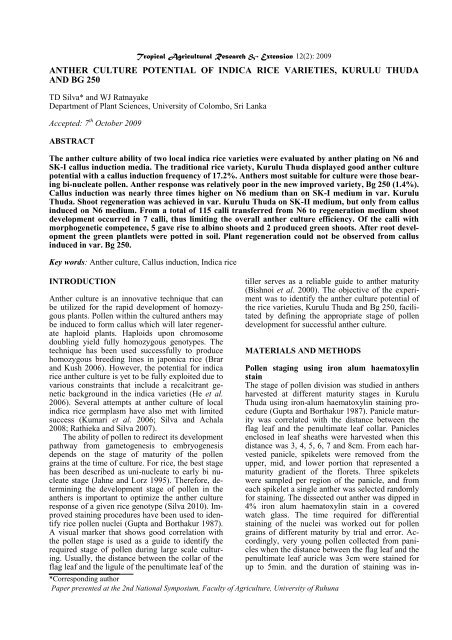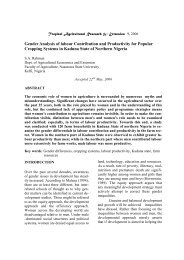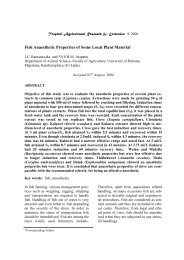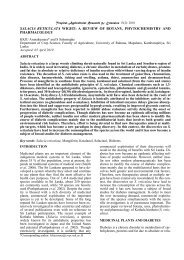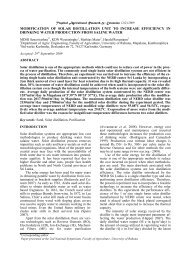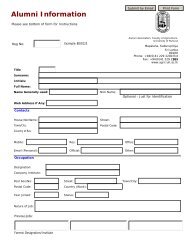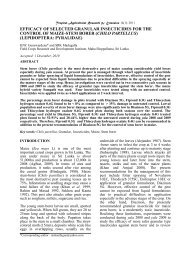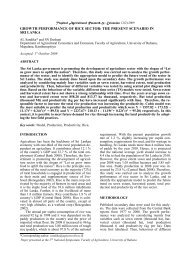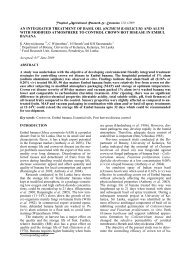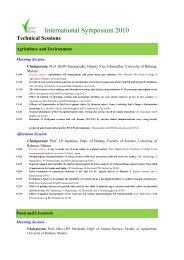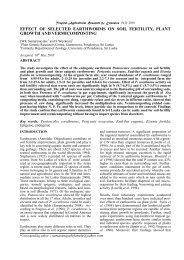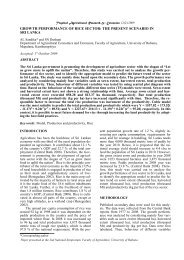anther culture potential of indica rice varieties, kurulu thuda and bg ...
anther culture potential of indica rice varieties, kurulu thuda and bg ...
anther culture potential of indica rice varieties, kurulu thuda and bg ...
Create successful ePaper yourself
Turn your PDF publications into a flip-book with our unique Google optimized e-Paper software.
Tropical Agricultural Research & Extension 12(2): 2009ANTHER CULTURE POTENTIAL OF INDICA RICE VARIETIES, KURULU THUDAAND BG 250TD Silva* <strong>and</strong> WJ RatnayakeDepartment <strong>of</strong> Plant Sciences, University <strong>of</strong> Colombo, Sri LankaAccepted: 7 th October 2009ABSTRACTThe <strong>anther</strong> <strong>culture</strong> ability <strong>of</strong> two local <strong>indica</strong> <strong>rice</strong> <strong>varieties</strong> were evaluated by <strong>anther</strong> plating on N6 <strong>and</strong>SK-I callus induction media. The traditional <strong>rice</strong> variety, Kurulu Thuda displayed good <strong>anther</strong> <strong>culture</strong><strong>potential</strong> with a callus induction frequency <strong>of</strong> 17.2%. Anthers most suitable for <strong>culture</strong> were those bearingbi-nucleate pollen. Anther response was relatively poor in the new improved variety, Bg 250 (1.4%).Callus induction was nearly three times higher on N6 medium than on SK-I medium in var. KuruluThuda. Shoot regeneration was achieved in var. Kurulu Thuda on SK-II medium, but only from callusinduced on N6 medium. From a total <strong>of</strong> 115 calli transferred from N6 to regeneration medium shootdevelopment occurred in 7 calli, thus limiting the overall <strong>anther</strong> <strong>culture</strong> efficiency. Of the calli withmorphogenetic competence, 5 gave rise to albino shoots <strong>and</strong> 2 produced green shoots. After root developmentthe green plantlets were potted in soil. Plant regeneration could not be observed from callusinduced in var. Bg 250.Key words: Anther <strong>culture</strong>, Callus induction, Indica <strong>rice</strong>INTRODUCTIONAnther <strong>culture</strong> is an innovative technique that canbe utilized for the rapid development <strong>of</strong> homozygousplants. Pollen within the <strong>culture</strong>d <strong>anther</strong>s maybe induced to form callus which will later regeneratehaploid plants. Haploids upon chromosomedoubling yield fully homozygous genotypes. Thetechnique has been used successfully to producehomozygous breeding lines in japonica <strong>rice</strong> (Brar<strong>and</strong> Kush 2006). However, the <strong>potential</strong> for <strong>indica</strong><strong>rice</strong> <strong>anther</strong> <strong>culture</strong> is yet to be fully exploited due tovarious constraints that include a recalcitrant geneticbackground in the <strong>indica</strong> <strong>varieties</strong> (He et al.2006). Several attempts at <strong>anther</strong> <strong>culture</strong> <strong>of</strong> local<strong>indica</strong> <strong>rice</strong> germplasm have also met with limitedsuccess (Kumari et al. 2006; Silva <strong>and</strong> Achala2008; Rathieka <strong>and</strong> Silva 2007).The ability <strong>of</strong> pollen to redirect its developmentpathway from gametogenesis to embryogenesisdepends on the stage <strong>of</strong> maturity <strong>of</strong> the pollengrains at the time <strong>of</strong> <strong>culture</strong>. For <strong>rice</strong>, the best stagehas been described as uni-nucleate to early bi nucleatestage (Jahne <strong>and</strong> Lorz 1995). Therefore, determiningthe development stage <strong>of</strong> pollen in the<strong>anther</strong>s is important to optimize the <strong>anther</strong> <strong>culture</strong>response <strong>of</strong> a given <strong>rice</strong> genotype (Silva 2010). Improvedstaining procedures have been used to identify<strong>rice</strong> pollen nuclei (Gupta <strong>and</strong> Borthakur 1987).A visual marker that shows good correlation withthe pollen stage is used as a guide to identify therequired stage <strong>of</strong> pollen during large scale culturing.Usually, the distance between the collar <strong>of</strong> theflag leaf <strong>and</strong> the ligule <strong>of</strong> the penultimate leaf <strong>of</strong> thetiller serves as a reliable guide to <strong>anther</strong> maturity(Bishnoi et al. 2000). The objective <strong>of</strong> the experimentwas to identify the <strong>anther</strong> <strong>culture</strong> <strong>potential</strong> <strong>of</strong>the <strong>rice</strong> <strong>varieties</strong>, Kurulu Thuda <strong>and</strong> Bg 250, facilitatedby defining the appropriate stage <strong>of</strong> pollendevelopment for successful <strong>anther</strong> <strong>culture</strong>.MATERIALS AND METHODSPollen staging using iron alum haematoxylinstainThe stage <strong>of</strong> pollen division was studied in <strong>anther</strong>sharvested at different maturity stages in KuruluThuda using iron-alum haematoxylin staining procedure(Gupta <strong>and</strong> Borthakur 1987). Panicle maturitywas correlated with the distance between theflag leaf <strong>and</strong> the penultimate leaf collar. Paniclesenclosed in leaf sheaths were harvested when thisdistance was 3, 4, 5, 6, 7 <strong>and</strong> 8cm. From each harvestedpanicle, spikelets were removed from theupper, mid, <strong>and</strong> lower portion that represented amaturity gradient <strong>of</strong> the florets. Three spikeletswere sampled per region <strong>of</strong> the panicle, <strong>and</strong> fromeach spikelet a single <strong>anther</strong> was selected r<strong>and</strong>omlyfor staining. The dissected out <strong>anther</strong> was dipped in4% iron alum haematoxylin stain in a coveredwatch glass. The time required for differentialstaining <strong>of</strong> the nuclei was worked out for pollengrains <strong>of</strong> different maturity by trial <strong>and</strong> error. Accordingly,very young pollen collected from panicleswhen the distance between the flag leaf <strong>and</strong> thepenultimate leaf auricle was 3cm were stained forup to 5min. <strong>and</strong> the duration <strong>of</strong> staining was in-*Corresponding authorPaper presented at the 2nd National Symposium, Faculty <strong>of</strong> Agri<strong>culture</strong>, University <strong>of</strong> Ruhuna
52TD SILVA AND WJ RATNAYAKE : ANTHER CULTURE OF INDICA RICEcreased up to 25, 60, 110, 130 <strong>and</strong> 140min. whenthis distance was 4, 5, 6, 7 <strong>and</strong> 8cm respectively.Stained <strong>anther</strong>s were squashed on a clean glassslide with a drop <strong>of</strong> haematoxylin stain, <strong>and</strong> observedunder the light microscope for stages <strong>of</strong> pollendevelopment.Anther CultureAnthers were dissected out from panicles harvestedat similar maturity stages as those used for pollenstaging. The panicles enclosed in leaf sheaths werewiped with 70% alcohol, <strong>and</strong> wrapped in aluminumfoil. Foil-wrapped <strong>and</strong> labeled panicles were placedin sealed plastic bags <strong>and</strong> subjected to cold pretreatmentat 10 0 C for 7d. Following cold-shock,panicles were surface sterilized in 20% Clorox for20min. Anthers were dissected out in the laminarflow bench from separated spikelets. Each spikeletwas snipped at the base while holding from the tip,to detach the <strong>anther</strong> lobes from the filaments. Thereleased <strong>anther</strong>s were dropped onto agar solidifiedmedia contained in Petri dishes. Anthers were madeto spread evenly on the agar surface by rotating thePetri dish during <strong>anther</strong>-plating. Anthers <strong>of</strong> the two<strong>varieties</strong> were <strong>culture</strong>d on N6 medium (Chu et al.1975) while <strong>anther</strong> response <strong>of</strong> Kurulu Thuda wastested in addition on a second callus induction medium,SK-I (Raina <strong>and</strong> Zapata 1997), as a surplus<strong>of</strong> <strong>anther</strong>s were available from this variety duringthe <strong>culture</strong> phase. N6 <strong>and</strong> SK-I media were supplementedwith 100mg L -1 yeast extract <strong>and</strong> containedAgNO 3 (10mgL -1 ) as an ethylene inhibiting agent todelay <strong>anther</strong> senescence (Lentini et al. 1995). Tworeplicate plates were maintained for each representativestage <strong>of</strong> panicle maturity in each variety. Aminimum <strong>of</strong> 318 <strong>and</strong> a maximum <strong>of</strong> 616 <strong>anther</strong>swere <strong>culture</strong>d per maturity stage depending on <strong>anther</strong>availability. Cultures were incubated in thedark at 25 0 C for callus induction.Callus produced on <strong>anther</strong>s were allowed todevelop to a size <strong>of</strong> about 3mm in diameter beforetransferring to regeneration medium. Shoot regenerationwas tested on SKH II medium (Raina <strong>and</strong>Zapata 1997) contained in Petri dishes, with eitheragar or agarose as the solidifying agent. When agarosewas used as the gelling agent, the initial transfer<strong>of</strong> callus was onto a hard medium containing1% agarose for subjecting the callus to water stress.After two weeks, the stressed callus was moved onto a s<strong>of</strong>ter medium with 0.4% agarose <strong>and</strong> maintaineduntil regeneration occurred. The growthregulators NAA, BAP, <strong>and</strong> kinetin were used, eachat 1mgL -1 in the regeneration medium. Two othergrowth regulator concentration regimes were alsotested where either NAA or kinetin concentrationwas reduced to 0.5mgL -1 while BAP concentrationremained at 1mgL -1 . Shoots that were regeneratedon SKH II medium in Petri dishes were transferredonto fresh agar-solidified media in test tubes to allowshoot elongation. Shoots which produced rootswere removed from the <strong>culture</strong> tube <strong>and</strong> the rootsystem was washed well in water. The plants with aweak root system were initially nurtured onHoagl<strong>and</strong> liquid medium <strong>and</strong> kept in the laboratoryfor 2 weeks, before moving into pots with soil <strong>and</strong>placed in the glass house.RESULTSPollen stagingAnthers <strong>of</strong> young panicles <strong>of</strong> Kurulu Thuda, harvestedwhen the distance between the flag leaf <strong>and</strong>penultimate leaf auricle was 3 <strong>and</strong> 4cm, containedonly uni-nucleate pollen irrespective <strong>of</strong> the spikeletposition within the panicle from which the <strong>anther</strong>swere obtained. When the above distance was 5 <strong>and</strong>6cm, <strong>anther</strong>s within the panicles had both uni- <strong>and</strong>bi-nucleate pollen with a higher percentage <strong>of</strong> binucleatecells in <strong>anther</strong>s <strong>of</strong> florets from the upperpart <strong>of</strong> the panicle. Only bi-nucleate pollen wasobserved in <strong>anther</strong>s from any part <strong>of</strong> the paniclewhen harvested from boots that correlated to 7 <strong>and</strong>8cm <strong>of</strong> the morphological marker distance.Callus induction from <strong>culture</strong>d <strong>anther</strong>sCallus development was observed 4 <strong>and</strong> 8 weeksafter <strong>anther</strong> plating in Kurulu Thuda <strong>and</strong> Bg 250,respectively. In Kurulu Thuda, mainly <strong>anther</strong>s frompanicles corresponding to the marker distance <strong>of</strong> 7<strong>and</strong> 8cm produced callus (Fig. 1a). In Bg250 callusinduction was observed only from <strong>anther</strong>s collectedfrom panicles when this distance was 6 <strong>and</strong> 7cm(Fig. 1b). This <strong>indica</strong>ted that the best responsivepollen for Kurulu Thuda were those in the binucleatestage. If the same correlation held forBg250 then the most appropriate pollen would be<strong>of</strong> the late uni-nucleate or early bi-nucleate stages,but this has not been verified in this study. In KuruluThuda, frequency <strong>of</strong> callus induction washigher in <strong>anther</strong>s harvested from panicles at the8cm distance (17.2%) compared to a much lower<strong>anther</strong> response (3.6%) relating to 7cm distance. InBg250, callus induction frequency was only 1.4%in <strong>anther</strong>s from panicles <strong>of</strong> 6cm distance <strong>and</strong> evenless (0.7%) for those from 7cm range (Table 1).Callus induction was better on N6 medium (3.6–17.2%) than on SK-I medium (0.6–3.3%) in KuruluThuda (Table 1). Callus produced in both <strong>varieties</strong>appeared creamy white in colour <strong>and</strong> friable in texture.Plant regeneration from induced callusFurther proliferation <strong>of</strong> callus occurred on the regenerationmedium (Fig. 1c). Shoot regenerationwas <strong>indica</strong>ted by the appearance <strong>of</strong> yellow-greencenters in the callus. Regeneration occurred in callus<strong>of</strong> Kurulu Thuda only, <strong>and</strong> this too from callus
Tropical Agricultural Research & Extension 12(2): 2009Table 1: Anthers producing callus from panicles harvestedat different stages <strong>of</strong> maturity on N6 <strong>and</strong> SK-Imedia, <strong>and</strong> the number <strong>of</strong> regenerated green plantsRicevarietyKuruluThudaCallusinductionmedium*Paniclematurity(cm)N6 6.07.08.0SK-I 6.07.08.0Bg 250 N6 6.07.08.0No. <strong>of</strong><strong>anther</strong>s<strong>culture</strong>d365616542322546379430594318002293021809060400No. <strong>of</strong>Callusing<strong>anther</strong>sFrequency<strong>of</strong>callusinductionNumber <strong>of</strong>green plantsregenerated0.03.617.2 12.00.63.32.4 -1.40.70.0 -*Panicle maturity estimated by the distance between the auricles <strong>of</strong>flag leaf <strong>and</strong> penultimate leaf at panicle harvestinduced on N6 medium. A total <strong>of</strong> 115 calli weretransferred from N6 callus induction medium toSKH II regeneration medium. However, the overall<strong>anther</strong> <strong>culture</strong> efficiency was poor <strong>and</strong> only 2 calliproduced green shoots (Fig. 1d), while albinoshoots were regenerated from 5 calli (Fig. 1e). Itwas not possible to assess the effect <strong>of</strong> growthregulator concentrations <strong>and</strong> media solidifyingagent on regeneration <strong>potential</strong> due to the smallnumber <strong>of</strong> calli showing morphogenetic competence.Clumps <strong>of</strong> green shoots developed rootswhen moved onto media in test tubes (Fig. 1f).Twelve fully regenerated green plants <strong>of</strong> KuruluThuda were transferred to pots in the glass house.frequency <strong>of</strong> <strong>indica</strong> variety Kurulu Thuda was distinctlybetter on N6 than on SK-I medium. Thissuggests that while some generalization on mediarequirements for the two ecotypes is possible, requirements<strong>of</strong> a particular variety within a subspeciesmay be specific for that genotype. Callus inductionfrequency observed for Kurulu Thuda canbe considered reasonably high by <strong>indica</strong> <strong>rice</strong> st<strong>and</strong>ards.However, manipulation <strong>of</strong> media componentscould yield further improvements.Callus induction <strong>and</strong> plant regeneration areconsidered as two distinct phases in the <strong>anther</strong> <strong>culture</strong>process <strong>of</strong> <strong>rice</strong>. Also it has been reported thatthe <strong>rice</strong> cultivars that display high callusing abilityshow the best regeneration frequencies (Javed et al.2007; Shahnewaz et al. 2003; Yan et al. 1996). Theresults obtained were consistent with this trend;callus induction was more successful in KuruluThuda <strong>and</strong> shoot regeneration also occurred fromthe same variety only. However, there are occasionsin which genotypes that show high callus inductionhave displayed poor regeneration ability<strong>and</strong> vise versa (He et al. 1998; Talebi et al. 2007).Shoot regeneration in Kurulu Thuda occurred fromcallus that was induced on N6 medium after transferto SK-II medium, but no regeneration occurredfrom callus transferred from SK-I induction medium.This <strong>indica</strong>tes that the callus induction mediumhas an influence on the morphogenetic com-53DISCUSSIONThe distance from flag leaf to penultimate leaf auricle,a convenient morphological marker that hasbeen previously used for estimating the maturitystage <strong>of</strong> pollen in different <strong>rice</strong> <strong>varieties</strong> (Bishnoi etal. 2000) could also be used as a visual guide in the<strong>indica</strong> variety, Kurulu Thuda.A clear difference in the <strong>anther</strong> <strong>culture</strong> responsewas observed in the two <strong>varieties</strong> <strong>of</strong> <strong>rice</strong>.The highest <strong>anther</strong> response (17.2%) in KuruluThuda was produced from the most mature <strong>anther</strong>sexamined (from panicles that correlated with the8cm distance). This was over 12 times better thanthe best response (1.4%) observed for Bg250. Similargenotype specificity <strong>of</strong> <strong>anther</strong> response withinthe <strong>indica</strong> subspecies has been observed to be common(Lentini et al. 1995; He et al. 2006; Shahnewazet al. 2003; Talebi et al. 2007).N6 proved to be the better medium for callusinduction in Kurulu Thuda. However, N6 mediumwhich contains inorganic nitrogen in the form <strong>of</strong>nitrate <strong>and</strong> ammonium ions is generally preferredfor japonica <strong>rice</strong> <strong>anther</strong> <strong>culture</strong>. Media in whichnitrogen in the ammonium form is considerablylow or absent, such as the SK-I, are considered betterfor <strong>indica</strong> <strong>varieties</strong> (Raina <strong>and</strong> Zapata 1997).However, in this experiment the callus inductiona b cd e fFigure 1: Callus induction <strong>and</strong> plant regenerationfrom <strong>culture</strong>d <strong>anther</strong>s <strong>of</strong> <strong>indica</strong> <strong>rice</strong> <strong>varieties</strong>. a-<strong>anther</strong>callus <strong>of</strong> Krulu Thuda; b-<strong>anther</strong> callus <strong>of</strong> Bg 250; c-proliferating callus <strong>of</strong> Kurulu Thuda; d-regeneratedgreen shoots; e-regenerated albino shoot; f–rooted plantlets
54petence <strong>of</strong> the induced callus, determining its regenerationcapability. Therefore, media manipulationsshould target the production <strong>of</strong> embryogeniccallus with good regeneration ability rather thansimply inducing prolific callusing, from which regenerationwould not be possible (Silva 2010).Of the seven sub-<strong>culture</strong>d calli from whichplant regeneration occurred, five gave rise to albinoplants <strong>and</strong> only two produced green shoots. Albinoplant regeneration is a problem that is commonlyencountered in <strong>rice</strong> <strong>anther</strong> <strong>culture</strong> that diminishesthe utility <strong>of</strong> the technique as a supplementarybreeding tool for <strong>rice</strong>.CONCLUSIONSGenotypic differences clearly influence the <strong>anther</strong><strong>culture</strong> ability <strong>of</strong> <strong>rice</strong>, <strong>and</strong> local <strong>rice</strong> variety KuruluThuda has good <strong>anther</strong> <strong>culture</strong> <strong>potential</strong>. Pollenstaging could contribute to the enhancement <strong>of</strong> <strong>anther</strong><strong>culture</strong> efficiency by correctly identifying thematurity stage <strong>of</strong> <strong>anther</strong>s in each variety prior to<strong>culture</strong>. The N6 medium was found to be adequatefor callus induction in Kurulu Thuda. Further improvementsmay be possible by manipulation <strong>of</strong>media components. However, <strong>anther</strong> <strong>culture</strong> efficiencymeasured in terms <strong>of</strong> the green plant regenerationability was poor. Regeneration has to beaddressed with detailed attention to media <strong>and</strong> <strong>culture</strong>conditions that would improve green plant production<strong>and</strong> lessen albino plant regeneration.REFERENCESTD SILVA AND WJ RATNAYAKE : ANTHER CULTURE OF INDICA RICEBishnoi U, Jain RK, Rohilla JS, Chowdhury VK,Gupta KR <strong>and</strong> Chowdhury JB 2000 Anther<strong>culture</strong> <strong>of</strong> recalcitrant <strong>indica</strong> x Basmati <strong>rice</strong>hybrids. Euphytica. 114: 93 – 101.Brar DS <strong>and</strong> Kush GS 2006 Cytogenetic manipulation<strong>and</strong> germplasm enhancement <strong>of</strong> <strong>rice</strong>(Oryza sativa L.). In: Genetic Resources, ChromosomeEngineering <strong>and</strong> Crop Improvement –volume 2, cereals. Ed. Singh RJ, Jauhar PP.CRC press. pp115-158.Chu C, Wang C, Sun C, Hsu C, Yin K <strong>and</strong> Bi F1975 Establishment <strong>of</strong> an efficient medium for<strong>anther</strong> <strong>culture</strong> <strong>of</strong> <strong>rice</strong> through comparative experimentson the nitrogen sources. Sci. Sin. 18:659 – 668.Gupta HS <strong>and</strong> Borthakur DN 1987 Improved rate<strong>of</strong> callus induction from <strong>rice</strong> <strong>anther</strong> <strong>culture</strong> followingmicroscopic staging <strong>of</strong> microspores iniron alum-haematoxylin. Theor. Appl. Genet.74: 95 – 99.He P, Shen LS, Lu CF, Chen Y <strong>and</strong> Zhu LH 1998Analysis <strong>of</strong> quantitative trail loci which contributeto <strong>anther</strong> culturability in <strong>rice</strong> (Oryzasativa L.). Mol. Breed. 4: 165 – 172.He T, Yang Y, Tu SB, Yu MQ <strong>and</strong> Li XF 2006 Selection<strong>of</strong> interspecific hybrids for <strong>anther</strong> <strong>culture</strong><strong>of</strong> <strong>indica</strong> <strong>rice</strong>. Plant Cell Tiss Organ Cult86: 271 – 277.Jahne A <strong>and</strong> Lorz H 1995 Cereal microspore <strong>culture</strong>.Plant Science.109: 1 – 12.Javed MA, Ishii T, Kamijima O <strong>and</strong> Misoo S 2007The role <strong>of</strong> alternating <strong>culture</strong> temperatures <strong>and</strong>maltose in enhancing the <strong>anther</strong> <strong>culture</strong> efficiency<strong>of</strong> salt tolerant inidca <strong>rice</strong> (Oryza sativaL.) cultivars, Pokkali <strong>and</strong> Nona Bokra. PlantBiotechnology. 24: 283 – 287.Kumari HMPS, Silva UND, Abayarathne WM,Abeysiriwardena DS De Z, YatawaraIWMKNK <strong>and</strong> Sirisena DN 2006 Annals <strong>of</strong> SriLanka Department <strong>of</strong> Agri<strong>culture</strong>:137 – 145.Lentini Z, Reyes P, Martinez CP <strong>and</strong> Roca WM1995 Androgenesis <strong>of</strong> highly recalcitrant <strong>rice</strong>genotypes with maltose <strong>and</strong> silver nitrate. PlantScience. 110: 127 – 138.Raina SK <strong>and</strong> Zapata FJ 1997 Enhanced <strong>anther</strong> <strong>culture</strong>efficiency <strong>of</strong> <strong>indica</strong> <strong>rice</strong> (Oryza sativa L.)through modification <strong>of</strong> the <strong>culture</strong> media.Plant Breeding.116: 305 – 315.Raina SK, Balach<strong>and</strong>ran SM, Virmani SS <strong>and</strong> ZapataFJ 1989 Improved medium for efficient<strong>anther</strong> <strong>culture</strong> <strong>of</strong> some <strong>indica</strong> <strong>rice</strong> hybrids. InternationalRice Research Newsletter. 14: 1.Ratheika V <strong>and</strong> Silva TD 2007 A study on the <strong>anther</strong><strong>culture</strong> response in different <strong>varieties</strong> <strong>of</strong><strong>rice</strong> (Oryza sativa L.) sub species <strong>indica</strong>. Proceedings<strong>of</strong> the 27 th Annual Sessions <strong>of</strong> the Institute<strong>of</strong> Biology, Sri Lanka.Shahnewaz S, Bari MA, Siddique NA, Khatun N,Rahman MH <strong>and</strong> Haque ME 2003 Induction <strong>of</strong>haploid <strong>rice</strong> plants through in vitro <strong>anther</strong> <strong>culture</strong>.Pakistan Journal <strong>of</strong> Biological Sciences. 6(14):1250 – 1252.Silva TD 2010 Indica <strong>rice</strong> <strong>anther</strong> <strong>culture</strong>: can theimpasse be surpassed? Plant Cell Tissue <strong>and</strong>Organ Culture. 100(1):1 – 11.Silva TD <strong>and</strong> Achala HHK 2008 Microspore stagingfor haploid cell <strong>culture</strong> in Oryza sativa subspecies<strong>indica</strong> (<strong>rice</strong>). Sri Lnaka Association forthe Advancement in Science. Proceedings <strong>of</strong>the 64 th Annual SessionsTalebi R, Rahemi MR, Arefi H, Nourozi M <strong>and</strong>Bagheri N 2007 In vitro plant regenerationthrough <strong>anther</strong> <strong>culture</strong> <strong>of</strong> some Iranian local<strong>rice</strong> (Oryza sativa L.) cultivars. Pakistan Journal<strong>of</strong> Biological Sciences. 10(12): 2056 –2060.Yan J, Xue Q <strong>and</strong> Zhu J 1996 Genetic studies <strong>of</strong><strong>anther</strong> <strong>culture</strong> ability in <strong>rice</strong> (Oryza sativa).Plant Cell Tiss Organ Cult. 45: 253 – 258(1996).


